Formula One: 1987 French GP
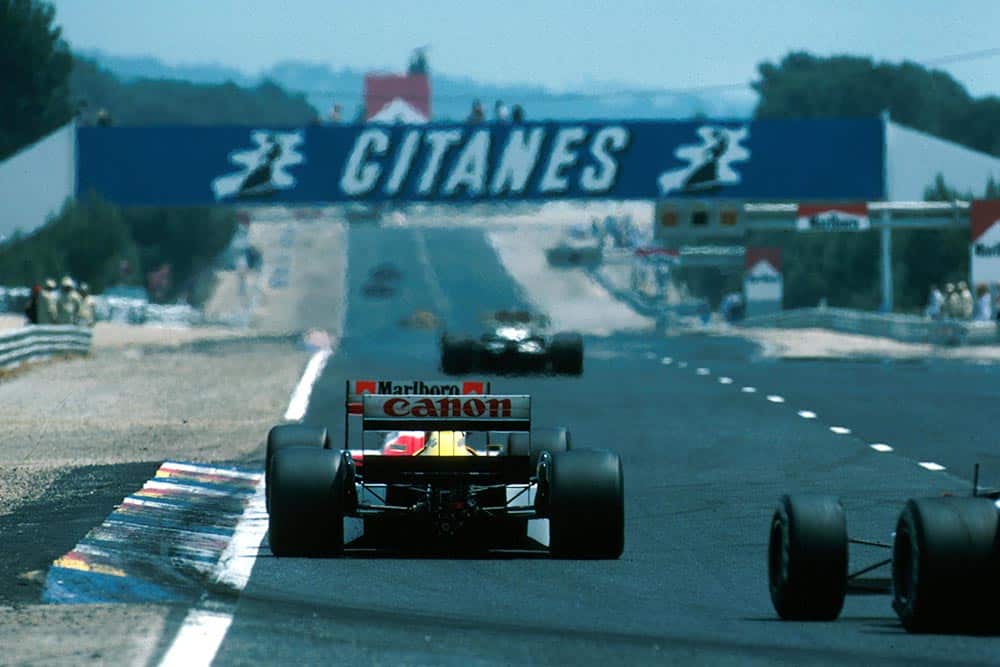
A view up the track French Grand Prix.
© Motorsport Images
Tour de force
Anyone who doubts which is the strongest team in Grand Prix racing today should have been at the French GP on July 5, and better still, at the two practice days prior to the race. If the Frank Williams team has a weak point, it does not show.
Nigel Mansell was as “on form” as Nelson Piquet was “off form”, but the result was total domination by the Williams FW11B cars, with their Honda V6 turbocharged power. The latest Japanese engines are beginning to make the Porsche/TAG V6 engines look a bit bulky and old-fashioned , while Ferrari’s 1987 engines and the Cosworth-built Ford V6 are no match for them at all.
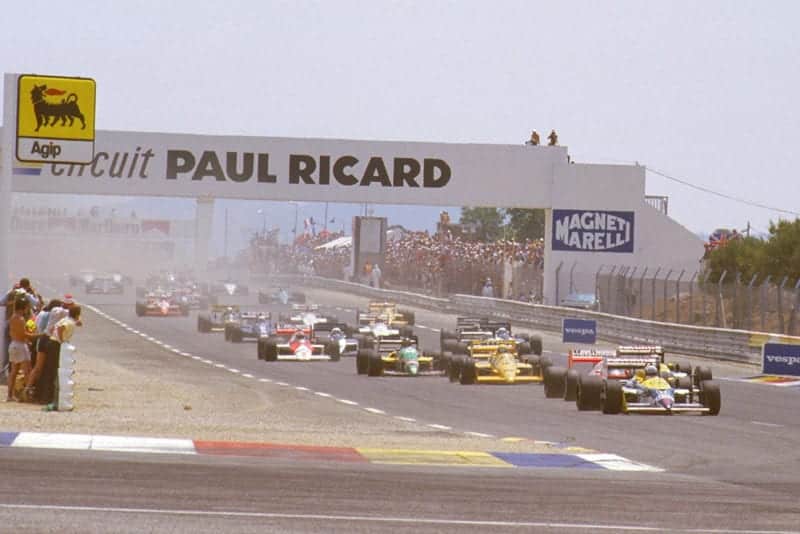
Nigel Mansell (Williams FW11B Honda) leads Alain Prost (McLaren MP4/3 TAG Porsche), Nelson Piquet (Williams FW11B Honda) and Ayrton Senna (Lotus 99T Honda) at the start.
© Motorsport Images
Throughout the weekend Nigel Mansell never put a foot or a wheel wrong, and he set fastest time in both qualifying sessions to claim undisputed pole position. He then led the race from the green light to lap 36, when he stopped for a new set of Goodyear tyres.
The two Williams drivers were using opposing tactics over tyres, Mansell deciding to make one stop, Piquet deciding on two Stops. The race was 80 laps in length, and new tyres were estimated to be at their peak performance for about ten laps, after which they would settle to a slightly slower performance. Mansell gambled on ten fast laps around the middle of the race, with only one stop, Piquet was aiming for two lots of ten-lap sprinting — one at one-third distance, the other at two-thirds — in spite of the handicap of two stops.
Piquet’s plan was spoiled when he stalled the Honda engine at his second tyre stop, and suffered an additional eight-second penalty while it was restarted. As well as this mistake, the Brazilian made two more in the course of the race, but recovered from them. He got crossed-up under braking for the sharp right-hander at the end of the pits straight, which allowed Prost to go past in the opening phase, and later in the race, while leading, he ran wide on a long, right-hand curve, allowing Mansell to dive through on the inside and take the lead, which he never relinquished. In spite of all this Piquet finished second to his team-mate, only 7.7 seconds in arrears, to make it a dominant result of first and second for the Williams-Honda team.
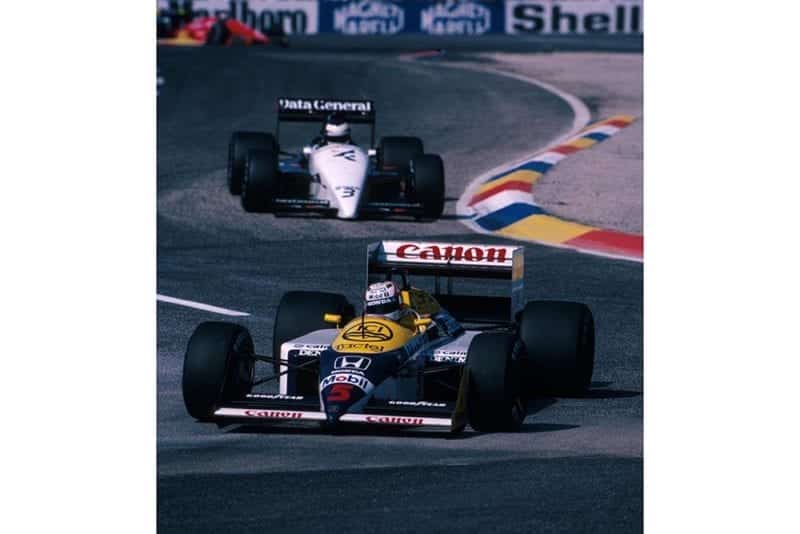
Winner Nigel Mansell in his Williams FW11B.
© Motorsport Images
Their only opposition came from Alain Prost, who claimed second position on the starting grid and ran second in the race for quite a time, until his Porsche engine showed signs of weakening and he had to settle for third place, after a very tenacious drive against a superior team.
For a brief moment in qualifying it looked as though Ayrton Senna might provide some opposition to the Williams cars, with his Lotus 99T using identical Honda power, but although he made third place on the grid it was at the expense of a blown-up engine, which did not amuse the army of Japanese technicians looking after the Honda units. In the race he was embarrassingly outclassed, the overall package Lotus could provide (as regards speed, economy, handling and road-holding, using the same power unit) proving no match for the Williams FW11B. It was all Senna could do to keep the Williams pair in sight for the front half of the race, and with the internal battle which was going on between the two cars from Didcot, Mansell actually lapped the “Yellow Peril” with nine laps to go!
Both Prost and Senna had to fight their battles alone, their team-mates being unable to help, for Johansson in the second McLaren was “run over” by de Cesaris on the opening lap, which called for a lengthy pit stop to replace his nose cone, and Nakajima in the second Lotus is not in the same league.
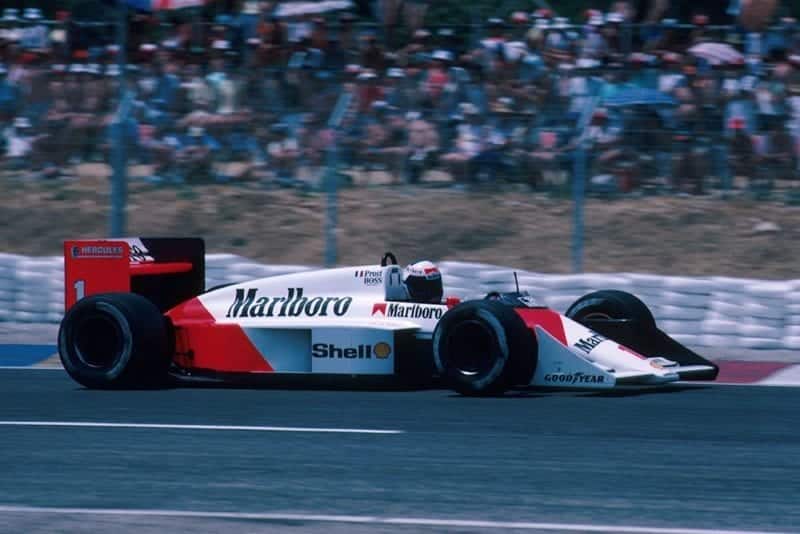
Alain Prost driving his McLaren MP4/3.
© Motorsport Images
For all the effect it had on the outcome of the race the Ferrari team might just as well have stayed in Maranello. In qualifying both Ferrari drivers were beaten by Thierry Boutsen in the second Benetton-Ford V6, and in the race they both made a nonsense of the start. Alboreto had “brainfade” on the grid, and jumped the start, thus incurring a one-minute penalty, and Berger nearly stalled his engine, and was swamped by all the tail-enders before he got it up on song. For Mr Ferrari, watching the television broadcast back in Maranello, it must have been humiliating to see his number one driver running a poor ninth (plus the one minute penalty) and his Austrian “whizz-kid” stuck in twelfth place, seemingly unable to get past Alessandro Nannini’s funny old Minardi. Added to all this John Barnard, who was taken on the Maranello strength at the end of last season to inject some “McLaren Magic” into the team, seemed to be distinctly out of favour all weekend, standing around without so much as a pencil and clipboard in his hand. Without ever featuring in the race, both Ferraris retired before the finish — a very black day for the Scuderia.
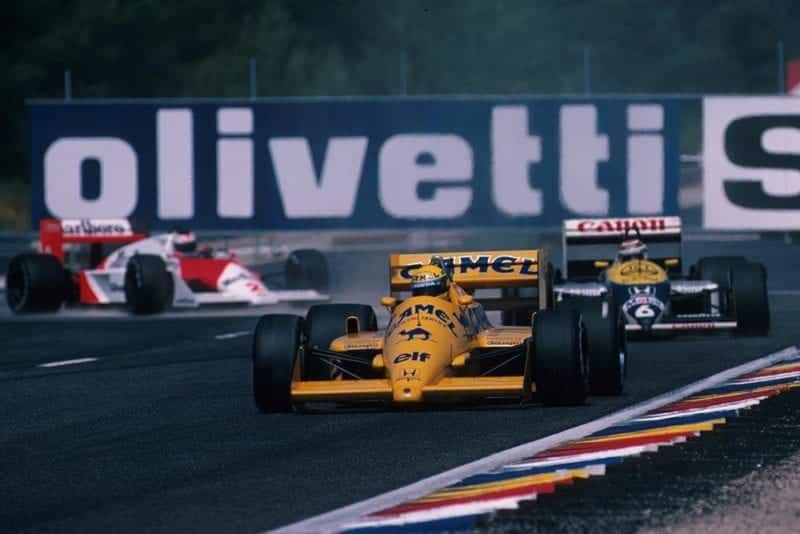
Ayrton Senna at the wheel of his Lotus 99T.
© Motorsport Images
By Williams standards, everyone else had a miserable time at the French Grand Prix, and while there are some circuits, such as Imola, Spa-Francorchamps or the Osterreichring, which exude a sympathy even to the most ill-treated team, the Circuit Paul Ricard on the dry, barren wasteland at Le Camp-Castellet does nothing to alleviate a miserable day.
With the British Grand Prix due to start only four days later there was little time for remorse or even analysis. It was back home and on with the next one for most people. From the beginning of practice on Friday morning there had been a strange air of hopelessness in the pit-lane. There seemed no real reason for anyone to be there, and apart from the Williams team, which was clearly hell-bent on destroying any opposition, there was a feeling that everyone else was treading water and waiting for something to happen, though nobody seemed quite sure what it was they were waiting for.
The little group comprising the Tyrrell team, Lola, March and AGS, with their “historic” racers using Cosworth V8 engines of great antiquity, had an air of unreality about them, and if they are supposed to represent what Grand Prix racing will be like in 1989 (when turbocharged engines are banned) the future looks distinctly gloomy.
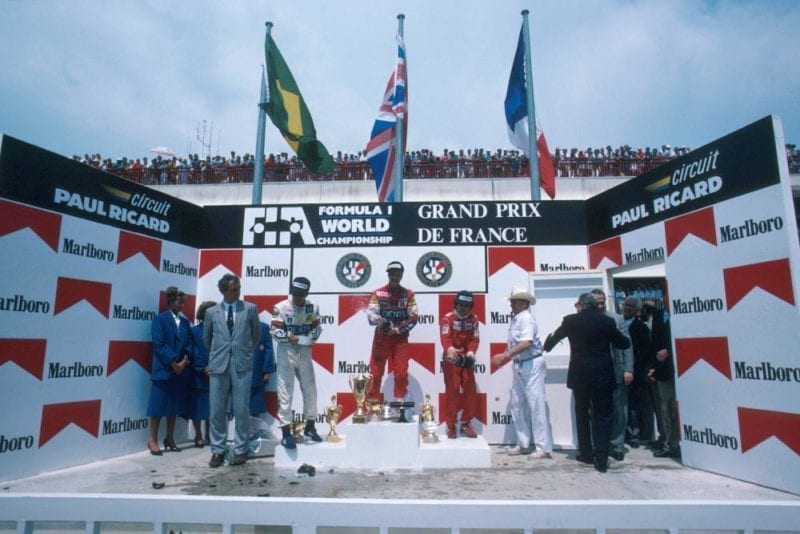
Winner Nigel Mansell, Nelson Piquet 2nd and Alain Prost 3rd on the podium.
© Motorsport Images
The also-rans who are supposed to be with the top league, were also looking very ineffectual in the face of the Williams-Honda force, and it was a sad sight to see the Brabhiun team among this part of the field, even though it still has the “lying down” factory BMW engines.
The spectator attendance was poor, a mere 48,000 counted over the three days according to official figures; perhaps it is just as well that the circuit was cut in half last year, otherwise the place would have looked very empty.
It is a long time since the French Grand Prix was a glowing example of racing in the grand manner, accompanied by gracious and elegant surroundings. The 1987 French Grand Prix can be considered an easily forgettable event for anyone except Frank Williams and his supporters. DSJi
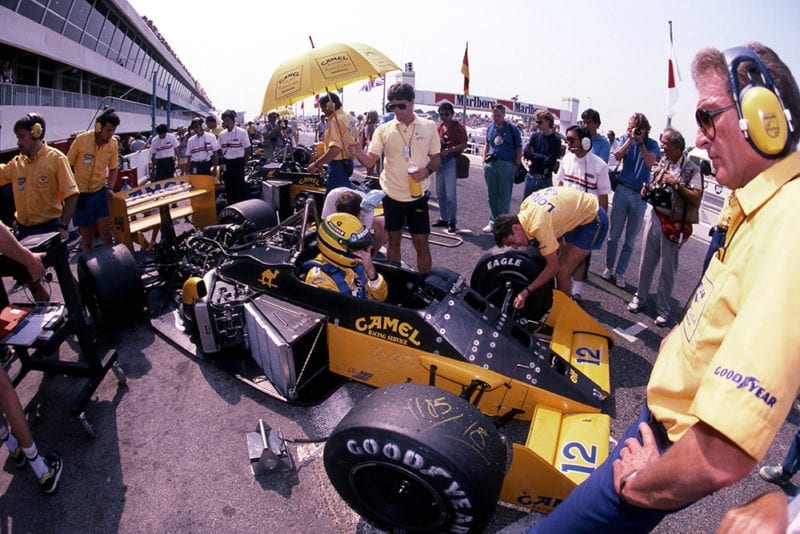
Ayrton Senna in the pits.
© Motorsport Images
